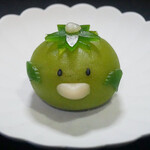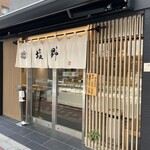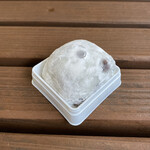
塩野
Shiono ◆ しおの
3.72
Akasaka
「Japanese Sweets」
1,000-1,999円
--
Opening hours: [Monday-Friday 10:00-18:00 [Saturday and holidays] 10:00-17:00
Rest time: Sundays Business hours and holidays are subject to change, so please check with the store before visiting.
東京都港区赤坂2-13-2
Photos
(20)




















Details
Reservation Info
can be reserved
Payment Method
Credit cards accepted
(VISA, Master, JCB)
Electronic money accepted
Number of Seats
(Take-out only)
Private Dining Rooms
None
Smoking and Non-Smoking
No smoking at the table
Parking
None
Comments
(19)
ジャッキー社長
3.80
I visited the famous traditional Japanese confectionery shop "Shiono" located a 3-minute walk from Akasaka Station. Established in 1947, this long-standing shop had no wait when I arrived around 10:30 am on a weekday. I purchased a box of two baked sweets for 890 yen. I chose the "Akasaka Nikki" and "Tosu Kagami." The Akasaka Nikki, a Hojiro-yaki with chestnut paste and a rich buttery aroma, was a delightful blend of Japanese and Western flavors. The Tosu Kagami, a moistly baked karumantou made with eggs and flour, was delicious with its hexagonal shape. I thoroughly enjoyed both treats until the last bite.




UK0123
3.80
I went to this shop around 1pm on Tuesday and there were no customers inside, so I took my time choosing. I ended up buying one piece of a small and affordable traditional Japanese sweet called Tokiwamatsu Monaka for 180 yen. I ate it later and it was easy to eat and had a refined taste. It was really good. Thank you for the meal! I will definitely go back again.




seven357
3.50
A famous traditional Japanese confectionery shop. It has a quiet and elegant storefront. The Tokiwamatsu mochi costs 180 yen and is filled with large red beans. The large dorayaki costs 330 yen and also contains red beans, making it sweet and satisfying. The Yae Kasumi costs 300 yen and is a delicate apple jam-filled biscuit. It is light and easy to eat. The packaging is also elegant.




Lady hana
3.70
A long-established Japanese confectionery shop in Akasaka. The compact store showcases beautifully crafted wagashi, such as dorayaki and mochi. I purchased the Kobore Hagi for 500 yen and Mizu-Yokan for 500 yen. The Kobore Hagi is wrapped in uirou with a yellow bean paste filling. The turquoise blue color is vibrant and visually appealing. The uirou is chewy, and the yellow bean paste inside is not too sweet, with a smooth and elegant sweetness. The Mizu-Yokan is refreshing, with a perfect level of firmness and a transparent sweetness. It is light and perfect for hot days. These refined Japanese sweets would make a great gift!




じゅみりん
3.60
It's a very lovely shop, and upon entering, I felt a bit tense. The variety and shapes of the main sweets are beautiful and delicate, catching the eye. Unfortunately, photos are not allowed inside the shop, so I don't have any to share. From the main sweets, I chose "Chrysanthemum Mochi." Since September 9th is the "Choyo no Sekku" festival, there were also fresh sweets called "Kise Momen" displayed in the outdoor showcase alongside chrysanthemum flowers. The "Chrysanthemum Mochi" I bought had mochi inside a crepe-like dough, with a chrysanthemum flower brand, and chrysanthemum leaves on top and bottom, making it a lovely sweet. There is a wide variety of dried sweets, all with a seasonal touch, likely popular for tea ceremonies. Although I've been away from the world of tea ceremonies for over 20 years, I found myself wanting to attend a class where the main sweets from this shop are served. The small-sized monaka was very elegant, with the shop's name and pattern on the skin, and the red bean paste was glossy. I also bought "Akasaka Nikki," which is not a traditional Japanese sweet, but it had a milky flavor, almost like a Western dessert. It had chestnut pieces inside, giving it a sweet overall taste that I enjoyed. The poetic naming is charming. I used to think that there was no match for Kyoto's traditional sweets, but learning about the many good shops in Tokyo made me feel ashamed for turning a blind eye to them.




もりC
3.70
I went to Akasaka and bought some sweets at Shiono-san. They mainly sell various Japanese sweets, with a focus on fresh sweets. I bought Yaegasumi. Inside the beautiful cherry blossom-colored packaging, there are biscuits. The soft texture and the apple jam sandwiched in between go really well together. It's a sweet that doesn't use sweet bean paste, but it's light and very easy to eat. I would like to try other Japanese sweets next time.



弥生ぃ(つ∀`*)
4.30
Founded in 1947, this confectionery shop has been serving high-class traditional sweets to customers in Akasaka, including those from the political, business, and imperial circles. The shop does not allow photography inside. One of their seasonal sweets, called Fusoka, is highly refined and delicious, with large grains of sweet bean paste inside. The shop accepts credit cards and IC transportation cards. The current owner, the second generation, trained at the renowned Osaka confectionery shop Tsuruya Hachiman before taking over the family business. The shop's name, Shionoguchi, is derived from the owner's former workplace "Shiose" and his childhood surname "Noguchi." They offer around 12 types of seasonal traditional sweets and about 15 varieties of half-dried confections that change monthly. Despite the strict no-photography policy inside the shop, the display outside showcases the exquisite products. The service was meticulous and attentive, living up to the reputation of this esteemed establishment.




ZDM1000R
3.50
"【Top 100 Stores in 2023】 Unbeknownst to me, a separate category for traditional Japanese sweets was created, separate from regular sweets. So I decided to stop by this shop near Tameike Sanno, called "Shiono." At this time of year, there was a notice saying that the sale of bean daifuku was suspended. I decided to try their famous Mizu Yokan instead. I bought the Mizu Yokan (with red bean paste) for 500 yen each. They are currently cooling in the refrigerator. The Mizu Yokan came in a small sealed container, and for 500 yen each, I had high expectations. The one with red bean paste had smooth paste, while the one with azuki beans had whole beans. I usually find mass-produced sweets from big companies too sweet and not to my liking, but the ones from this shop have a different kind of sweetness. They are definitely delicious."




甘楽138ああああああああああああああああ
3.00
There are tables in the store, but it is intended for takeout only, not for dining in.
Items purchased:
- Kikyo (500 yen)
- Dorayaki (330 yen)
- Mizu yokan (500 yen)
Payment method: Credit card
The Kikyo was chewy and delicious! The dorayaki was also voluminous and I want to eat it again. The yokan had a clear and delicious taste!!



もう腹が減った。
3.90
Every month, they offer 10 types of seasonal wagashi. Each wagashi is beautiful and suitable for serving to guests.
■ Order Details
- Tokiwasou Monaka (180 yen): A refined, elongated monaka with a delicious anko filling. It was my favorite among the monaka varieties.
- Setsugen Kan (500 yen): Pronounced "mizorekan," this is a popular summer wagashi. By adding shiratama flour to agar, they create a cool, beautiful appearance resembling snow or ice. It has a refined sweetness with koshian in the center.
■ Miscellaneous Notes
The staff were polite and answered my questions about the wagashi thoroughly.




1sara
4.10
A shop in Akasaka that was selected as one of the top 100 traditional Japanese sweets and confectionery shops in Tokyo in 2023. The shop has a refined and beautiful appearance, offering a variety of sweets such as yokan, baked sweets, dried sweets, and steamed buns. In particular, the assorted dried sweets priced at 180 yen are colorful and beautiful, making them a great gift for someone special. During a visit on a weekday evening before the announcement of the top 100 traditional Japanese sweets and confectionery shops, the water yokan was already sold out. Instead, I tried the "Matsunatsu" priced at 500 yen, a summer-themed wagashi. It featured a sunflower with leaves, made from finely cut petals of three different colored nerikiri. It was a beautifully elegant and sweet treat. Thank you for the meal.




リンゼ♪
3.50
Salt Field: Mizuyokan and Fuyokan for ¥1000, located 2 minutes walk from Akasaka Station (4 minutes walk from Tameike-Sanno Station), closed on Sundays. After having lunch, I decided to have some sweets! Today, I wanted to have Japanese sweets since I rarely have them. There were tempting baked goods like dorayaki, but I opted for wagashi (Japanese sweets) this time. I love Mizuyokan, so I chose that along with Fuyokan, a type of wagashi. Fuyokan seemed to be a flower-themed wagashi. Mizuyokan had a smooth texture and was delicious, but it was a safe choice, maybe I should have tried something else. Fuyokan had pink anko (sweet red bean paste) inside a transparent jelly-like part. It resembled the Fuyou flower, which I coincidentally knew from a game. Japanese sweets are visually appealing, with a different kind of beauty compared to Western sweets. The white sesame seeds on top of Fuyokan added a nice aroma and were a great accent. It was a lovely shop that made me want to try other sweets as well. Thank you for the meal!




a_takky
4.00
Sazareishi is a sweet treat that can cool you down even in the hot summer. It is not too sweet. The pink bean paste wrapped in kudzu mochi is glossy like a water lily. When the rainy season ends, the heat suddenly increases. Dorayaki has a moist and fine texture, with a soft and pleasant mouthfeel. The finished product is also beautiful. The anko filling is made from large grains of Tanba Dainagon azuki beans. The dorayaki from Shiono is my number one choice. Delicious! Delicious! Delicious!




12りりり
4.00
Perfect for souvenirs! A well-known traditional Japanese confectionery shop with two other customers on a Saturday morning. It was my first visit, and I bought manju, amber sugar, and wagashi. They had about 8 different types of wagashi, all delicate and elegant in appearance. The flavors were not too sweet and very delicious. A bit pricey, but I would love to try them again on a special occasion!

tartetatin88
2.80
I bought some wagashi, dorayaki, and manju for home use. The atmosphere inside the store was very elegant and lovely. The sweets didn't quite suit my taste, so I rated them lower. There are other sweets I would like to try, so I plan to visit again. Thank you for the meal.


@なゆたぬき
4.10
I happened to come across Kappa no Kawataro at a Japanese sweets shop I entered out of curiosity. Although I was also interested in the mosquito coil-shaped sweet called "Kaya," I ultimately decided to take home this cutie, Kawataro. It's just too cute! Turning a kappa into a Japanese sweet is such a clever idea. Even the back and head are adorable! The seasonal Japanese sweets at this shop are all wonderful, so I definitely want to visit regularly. I heard they offer around 10 different types of seasonal wagashi every month, so it's worth checking out!




Casual Gourmet Quest
3.70
After having lunch in Akasaka, I passed by a shop around 1:20 PM and decided to check if they had daifuku or dorayaki. Unfortunately, the daifuku was sold out, but they still had dorayaki available. The dorayaki was priced at 330 yen including tax. It had a pancake-like texture with a nicely browned surface, a soft and fluffy interior with a good thickness, and a refined yet substantial taste. The filling consisted of large red bean paste that was both chunky and of high quality sweetness. Among the various dorayaki available, this one was a favorite of mine. The shop offers a wide selection of beautifully presented traditional Japanese sweets, making it popular for gifts. The service is excellent, with attentive customer care for regulars and newcomers alike. If you're looking to buy traditional Japanese sweets for gifts in the Akasaka area, this shop is highly recommended. Additionally, purchasing dorayaki or daifuku for personal consumption at home is also a great idea.


milan1110
3.50
Today we visited a popular shop in Akasaka that offers a wide range of traditional Japanese sweets. Unfortunately, photography is not allowed inside the store. This time, we purchased a dorayaki for 330 yen including tax. The moist cake-like exterior had minimal air bubbles and a classic pancake-like texture. The filling was sweet red bean paste with noticeable bean grains, providing a satisfyingly substantial taste. The sweetness level was just right, not overly sweet or cloying. Overall, it was a delicious dorayaki and we left satisfied. Thank you for the meal.



まちこ87229
2.70
I entered the store around noon. There was one customer before me. The interior of the store gave a very clean impression. The staff was very calm and pleasant. Photography was not allowed inside the store. This time, I purchased a red bean daifuku (330 yen). It was the most expensive daifuku I've ever bought. Review of the red bean daifuku: Sweetness of the red bean ★★★☆☆. It was not overly sweet, just the right amount. The red bean paste was smooth and elegant. Beaniness of the daifuku ★★★★★. I wished there was a bit more bean flavor. The special feature of this daifuku is its large size and thick skin. I personally like thick skins, so I was happy about that. The thick skin and large size gave it a satisfying texture. Overall, it was a delicious daifuku. However, 330 yen is a bit expensive. I would rate it 2.7 out of 5, considering that there are similar quality daifuku available at a lower price.




Email Login